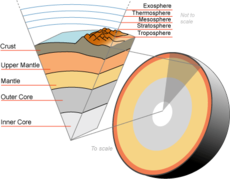The Earth's crust is the Earth's hard outer layer. It is less than 1% of Earth's volume. The crust is made up of different types of rocks: igneous, metamorphic, and sedimentary rocks.

Below the crust is the mantle. The crust and the upper mantle make up the lithosphere. The lithosphere is made of tectonic plates, which move very slowly.
The crust is of two different types. One is the continental crust (under the land) and the other is the oceanic crust (under the ocean).
- The continental crust is thicker, 30 km (20 mi) to 50 km (30 mi) thick. It is mostly made of less dense, more felsic rocks, such as granite.
- The oceanic crust is thinner, 5 km (3 mi) to 10 km (6 mi) thick. It is made of denser, more mafic rocks, such as basalt.
The temperature of the crust increases with depth because of geothermal energy. Where the crust meets the mantle the temperatures can be between 200 °C (392 °F) to 400 °C (752 °F).[1] The crust is the coldest layer because it is exposed to the atmosphere.
| Oxygen | 46.6% |
| Silicon | 27.7% |
| Aluminium | 8.1% |
| Iron | 5.0% |
| All others | 12.6% |
Composition
change-
Abundance (atom fraction) of the chemical elements in Earth's upper
continental crust as a function of the atomic number.
Igneous rocks make up over 90% of Earth's crust by volume.[2]p47 This is not noticeable because they are mostly covered by sedimentary and metamorphic rocks.
A single family of silicates, the feldspars, account for about half of the material in the crust (60% by weight), and quartz is a sizeable proportion of the rest. Other common minerals are mica and hornblende.
Only 8% of Earth's crust is non-silicate minerals, and this includes carbonates, sulfides, chlorides and oxides.
Formation of the crust
changeEarth's mantle and crust formed about 100 million years after the formation of the planet, about 4.6 billion years ago. At first the crust was very thin, and was probably changed often as the tectonic plates shifted around a lot more than they do now. The crust would have been destroyed many times by asteroids hitting Earth, which was much more common in the Late Heavy Bombardment.
The oldest oceanic basalt crust today is only about 200 million years. Most of the continental crust is much older. The oldest continental crustal rocks on Earth are cratons between 3.7 and 4.28 billion years old.[3][4] These have been found in the Narryer Gneiss Terrane in Western Australia, in the Acasta Gneiss in the Northwest Territories on the Canadian Shield, and on the Fennoscandian Shield. A few zircons at least 4.3 billion years old have been found in the Narryer Gneiss Terrane in Western Australia.
The average age of Earth's continental crust is about 2.0 billion years.[5] Most crustal rocks formed before 2.5 billion years ago are in cratons. Such old continental crust and the mantle below it are less dense than other places in the Earth. These are not easily destroyed when the plates shift. The making of new continental crust was done in times of major orogeny or mountain building. This happened at the same time as the formation of the supercontinents, such as Rodinia, Pangaea and Gondwana. The crust formed in part by the coming together of island arcs. These were made of granite and metamorphic fold belts. They are kept together partly by the subduction of the mantle below the crust, which makes a mantle on which the crust float.
References
change- ↑ http://www.channel4.com/science/microsites/S/science/nature/journey.html Earth
- ↑ Levin, Harold L. The Earth through time. 5th ed, Saunders.
- ↑ "Team finds Earth's 'oldest rocks'". 26 September 2008 – via news.bbc.co.uk.
- ↑ P.J. Patchett and S.D. Samson 2003. Ages and growth ot the continental crust from radiogenic isotopes. In The Crust (R.L. Rudnick ed) volume 3, pages 321-348 of Treatise on Geochemistry (H.D. Holland and K.K. Turekian eds) Elsevier-Pergamon, Oxford.
- ↑ A.I.S. Kemp and C.J. Hawkesworth 2003. Granitic perspectives on the generation and secular evolution of the continental crust.